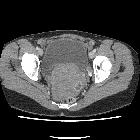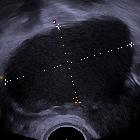hemoperitoneum
 ähnliche Suchen
ähnliche Suchen siehe auch
siehe auchHemoperitoneum (plural: haemoperitoneums) is the presence of blood within the peritoneal cavity.
Pathology
Etiology
- penetrating or non-penetrating abdominal trauma (often with associated organ injury)
- ruptured ectopic pregnancy
- ovarian cyst rupture
- aneurysm or pseudoaneurysm rupture
- neoplasm rupture
- acute hemorrhagic pancreatitis
- iatrogenic
- spontaneous bleeding, especially patients with coagulopathy or on anticoagulant therapy (uncommon)
Radiographic features
Ultrasound
- non-specific appearance of intraperitoneal free fluid
- may be hypo-, iso- or hyperechoic
- may demonstrate fluid-fluid levels with mixed internal echogenicity
CT
The density of fluid in the abdomen suggests its composition (i.e. ascites/bowel contents/bile vs hemorrhage) :
- recent hemorrhage (acute bleed) measures 30-45 HU
- clotted blood measures 45-70 HU
- old blood products/seroma or blood in patients with anemia may measure <30 HU
A collection of blood products can be homogeneous or heterogeneous (often low density with internal linear/nodular hyperdensities) ; fluid-fluid levels are often present.
MRI
- acute (<48 hours) hemoperitoneum has non-specific signal characteristics
- subacute (>3 weeks) may demonstrate concentric ring sign
- fluid-fluid levels (hematocrit effect) with high T1 / low T2 signal noted dependently
Differential diagnosis
- low-density hemoperitoneum may be indistinguishable from ascites or other causes of peritoneal free fluid
- there may be a delayed increase in ascites attenuation after administration of IV contrast (up to 3 days)
- there may be an increase of up to 25 HU
Siehe auch:
- Endometriose
- peritoneal cavity
- eitrige Perikarditis
- hämorrhagische Pankreatitis
- intraabdominelle Blutungen
und weiter:
 Assoziationen und Differentialdiagnosen zu Haemoperitoneum:
Assoziationen und Differentialdiagnosen zu Haemoperitoneum:

























